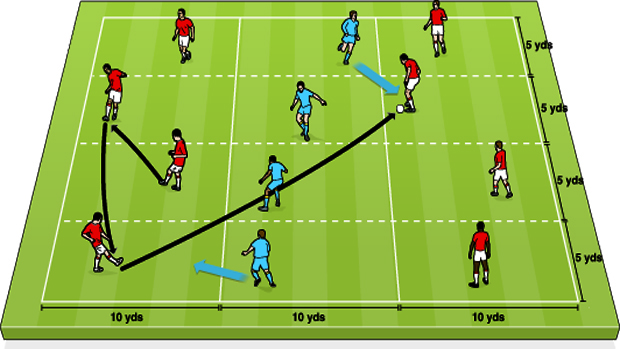How to defend against a passing team
You’ll stop any team playing through you with a little teamwork, organisation and communication, says Jimmy Gilligan, Nottingham Forest first team coach

Set-up
Mark out a grid of 30 x 20 yards divided into three sections, comprising two end zones and a middle zone, each measuring 10 x 20. Each zone is divided into four boxes of 10 x 5. In each end zone, place an attacking team of four players. Position a defensive team of four in the middle zone. Each player can only move within the confines of their own box. Only one ball is used.
Drill
The aim of the respective attacking teams is to keep possession in their zone and wait for an opportunity to pass through the middle defensive line to the other end zone – along the floor. The defence has to work as a unit to close off the space and stop the ball being switched from one end to another.
Progression
When the ball is played into an end zone, allow one of the defenders in the middle to leave his box and press the ball, creating four-vs-one. If the attacking team then switch the ball to the opposite end zone, the defender has to return to his station and another is allowed to press the attacking team.
How it helps
Get FourFourTwo Newsletter
The best features, fun and footballing quizzes, straight to your inbox every week.
This drill teaches the back four how to work as a unit. Defenders have to learn to communicate and decide when to shut down the space quickly – this is especially relevant when introducing the progression. The nearest man to the ball presses the play and has to learn to get his distances right: if he’s too far away the attacker beats him, if he gets too tight he has too much ground to make up behind.
Related article: Defend from the wings
Close off all passing avenues during a game
You’d apply this drill in the middle of the defending team’s half. For instance, if the ball gets played wide to the right midfielder, the left-back has to go out to meet him.
As soon as the left-back goes out to meet the right midfielder the other defenders must get round, shuffle across and make the pitch smaller.
The distances between the defenders have to be tight and compact – this requires loud and clear communication.
The aim of the defence in this situation is to deny space to the opposition and close the gaps between one another so the ball can’t be played through.
If you watch teams like Barcelona and Arsenal, they’re masters of passing their way through a back four.
If you’re playing against a team that replicates this style you’ll want to keep them wide to stop them coming through the middle.
